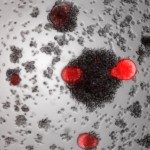Lien vers Pubmed [PMID] – 14627832
Nucleic Acids Res. 2003 Dec;31(23):6996-7002
The translation initiation region (TIR) of the Escherichia coli rpsA mRNA coding for ribosomal protein S1 is characterized by a remarkable efficiency in driving protein synthesis despite the absence of the canonical Shine-Dalgarno element, and by a strong and specific autogenous repression in the presence of free S1 in trans. The efficient and autoregulated E.coli rpsA TIR comprises not less than 90 nt upstream of the translation start and can be unambiguously folded into three irregular hairpins (HI, HII and HIII) separated by A/U-rich single-stranded regions (ss1 and ss2). Phylogenetic comparison revealed that this specific fold is highly conserved in the gamma-subdivision of proteobacteria (but not in other subdivisions), except for the Pseudomonas group. To test phylogenetic predictions experimentally, we have generated rpsA’-‘lacZ translational fusions by inserting the rpsA TIRs from various gamma-proteobacteria in-frame with the E.coli chromosomal lacZ gene. Measurements of their translation efficiency and negative regulation by excess protein S1 in trans have shown that only those rpsA TIRs which share the structural features with that of E.coli can govern efficient and regulated translation. We conclude that the E.coli-like mechanism for controlling the efficiency of protein S1 synthesis evolved after divergence of Pseudomona.

